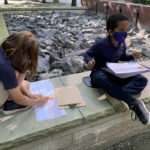Due to the COVID-19, also known as Coronavirus, emergency, many IB World Schools are successfully using online learning to continue students’ education, says IB Curriculum Manager Pilar Quezzaire. Two educators share their experiences.

The COVID-19, also known as Coronavirus, outbreak continues to cause governments and municipalities to close schools across the globe. Rather than halt learning and teaching altogether, schools in the IB community have instead turned to online learning. The results of their efforts have illustrated these schools’ resilience and resourcefulness and tested the value and efficacy of learning, teaching and leading online.
While the final outcomes of online learning as a response to this emergency are not yet known, stories from schools indicate that there is an upside to online learning and teaching that schools can take into their futures after the emergency is over.
Two technology leaders from IB World Schools in China discuss the unexpected positives that have arisen from their experiences with learning and teaching online.
Coordinating teachers and students
When the Chinese government ordered schools to be shut down due to the COVID-19 outbreak, students and teachers at IB World Schools Shanghai American School (SAS) and Western Academy of Beijing (WAB) were on vacation for the Chinese New Year. Faculty and families were scattered across the world and unable to return to China. Both schools had to respond to the situation as quickly as possible.
SAS leadership implemented an emergency online learning programme. In the process, they discovered that their students and teachers resided across five continents and 22 time zones. The first challenge for SAS was to figure out how to get everyone enough online learning and teaching time.
Director of Technology Alan Preis says: “At first, learning was almost entirely asynchronous [not online simultaneously] because we assumed we’d be closed for a short time. Now, we have implemented more options for synchronous [groups online at the same time] instruction. But equitable access is a huge issue based on time zones―it is almost impossible to have all students working together with a teacher at the same time.” The Shanghai American School Distance Learning Plan continues to evolve as the school must remain closed longer than originally expected.
“We are inspired by the communities of practice that are strengthening through online collaborative planning”
SAS has had to distribute teachers’ time across different time zones, creating shorter meeting times, more one-to-one conversations with students and more spontaneous teaching moments as students worked on their assignments. SAS leadership has been impressed by how well the teachers have responded despite the stresses of teaching in a different way as well as in a new medium. “The teachers got five years’ worth of professional learning in two weeks,” adds Preis.
WAB faced similar challenges, determining when and how the school could coordinate teachers, students, parents and legal guardians to ensure learning and teaching continued effectively. One area that needed special attention was how to teach younger learners online in accordance with Primary Years Programme (PYP) and Middle Years Programme (MYP) frameworks.
The school is using video and interactive learning to create the feel of a, “real school”, in a way that helps parents cope. They are thinking about, “how to reduce the great secretarial burden on parents”, while providing a learning experience that keeps children and parents engaged, according to Stephen Taylor, MYP coordinator and incoming director of innovation in learning and teaching at WAB.
The teachers and leadership team also had to examine the evidence, then consider how collecting different kinds of data and information could make the process of documentation easier. This influenced wider discussions across all age groups as to what effective assessment might look like.
Similar to SAS, WAB teachers have commented that the closure has stimulated some of the most intense, “just in time”, professional learning they have experienced. Tech integrators and many teachers are offering and participating in WAB Lab online shared-learning workshops and tutorials to support each other.
Strengths of online learning
Both schools discovered online learning and teaching provide certain affordances that differ from face-to-face instruction.
Students and teachers demonstrate more agency. In the online context, teachers have more agency over classroom interaction and have more time one-on-one with students to examine their ideas. Students can submit their ideas and talk together in various ways, encouraging not only their independence but also their skills in multimodal communication and presentation.
Collaboration has not suffered: “We are doing a ton of work with and between students online using our platforms,” explains Preis. While Taylor emphasizes, “At WAB, colleagues are finding a new appreciation for each other. We are inspired by the communities of practice that are strengthening through online collaborative planning.”
Teachers have engaged in deep conversations on what is essential to teach and assess and how to translate academic integrity into the very modern modes in which their students regularly communicate. “The COVID-19 outbreak has opened up conversations about, “what is assessment? What makes acceptable evidence of understanding?’,” says Taylor. “What we are trying to get to is that formative assessment is an ongoing process that helps to validate other aspects of the programme. Now we’re into this extended phase where we have to get into summative assessment. We don’t want it to be inauthentic.”
Learning and teaching continue and change
“We’re coming together as a team, doing design thinking, over hours instead of weeks”
Students are finding creative ways to conduct and document their service and action despite their separation from school. WAB students have raised funds for medical supplies in Wuhan, and SAS students conducted an online orchestra as part of the work for the creativity, activity, service (CAS) component of the Diploma Programme (DP).
Learning management while online is more effective and is positively influencing teaching design. WAB teachers have been taking on the challenge of learning new tools, and there is, “a renewed love for reliable, China-friendly platforms, such as Moodle and blogs”, due to the school closing. SAS teachers are changing their behaviours to be more responsive to rapid evolutions of the distance learning plan. “We’re coming together as a team, doing design thinking, over hours instead of weeks,” says Preis.
With online learning comes a wealth of information, but the ways to use it are very different than in face-to-face environments. Taylor says: “We have a river of information versus buckets of tests―you’re being showered in it versus getting it dumped on you.”
Preis continues to work with the SAS leadership team on data captured in online learning and plans are in progress to examine the data from the experience both in real-time and after the school community comes together again. “What does this data tell us about learning and teaching in the school more generally?” he asks.
All in all, learning and teaching continue, evolve and change in the face of the COVID-19 outbreak. Schools who have taken up the challenge of online learning have discovered a simple truth: that online learning and teaching are unique and have their own strengths that are not necessarily comparable to face-to-face instruction. Amid concerns from schools that online learning and teaching are, ‘not equal’, Preis has this to say: “I would agree that it’s not equal but that doesn’t necessarily mean worse. It’s different.”
At the very least, online learning and teaching is making a huge difference to schools facing closure.
Look out for more blog posts on how schools are using online learning due to the Coronavirus outbreak. For more advice download the IB’s online learning, teaching and education continuity planning for schools
If you enjoyed this story, consider reading more below:




Comments are closed.